VET: Interests and Challenges for Australian Employers - Essay
VerifiedAdded on 2021/06/18
|7
|1827
|66
Essay
AI Summary
This essay delves into the realm of Vocational Education Training (VET) in Australia, specifically focusing on the perspectives of employers. It identifies two key interests driving employers' engagement with VET: the acquisition of diverse skills for workers, which in turn fosters economic growth, and the development of a skilled workforce that contributes to social inclusion and a strong foundation for the future. The essay also sheds light on the challenges employers encounter within the VET sector, including resourcing issues, financial constraints, difficulties in accessing relevant information about training programs, and concerns about the quality and relevance of training content. The essay emphasizes the importance of VET in addressing skills gaps and ensuring that the workforce is equipped with the necessary skills to meet the evolving demands of the business landscape.
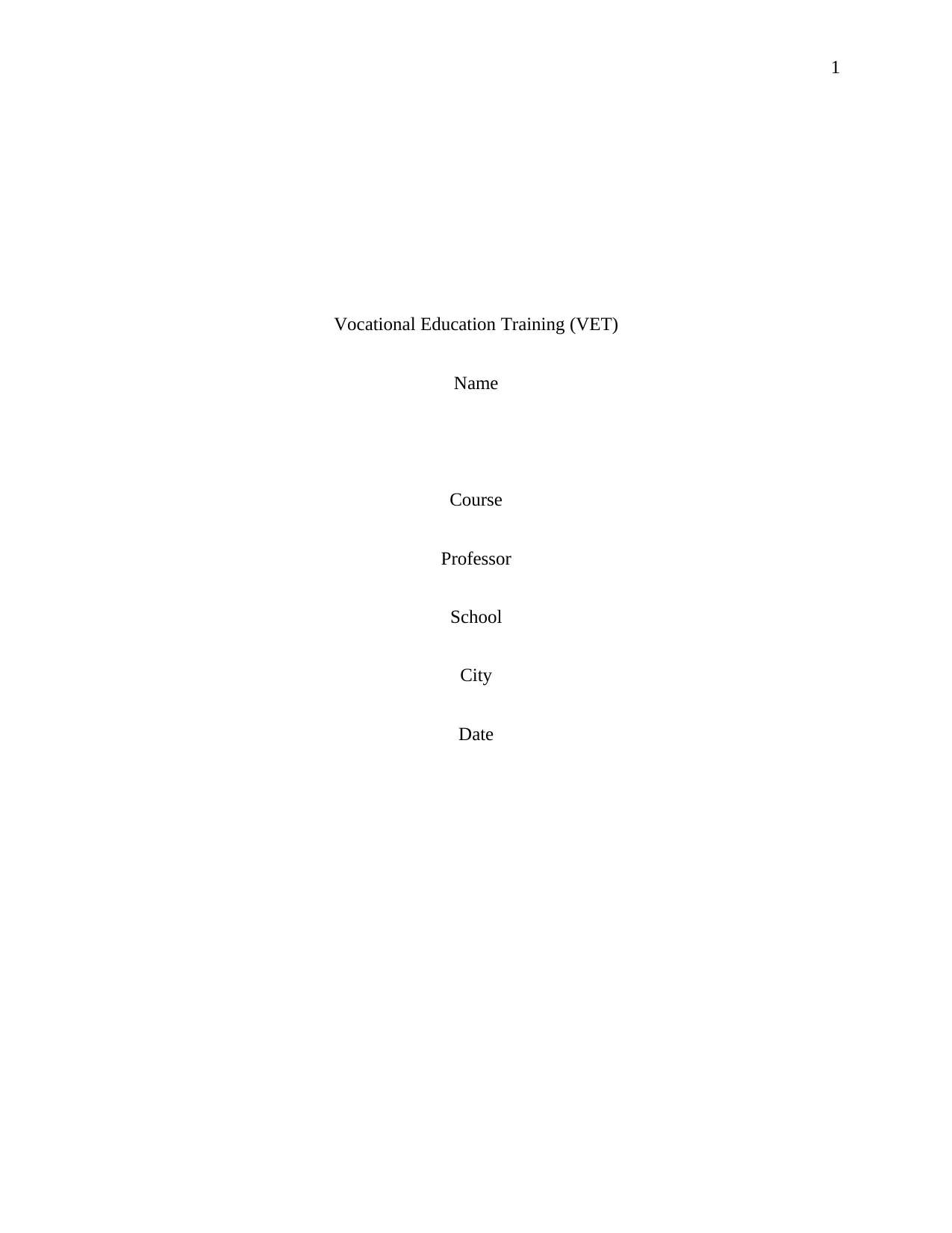
1
Vocational Education Training (VET)
Name
Course
Professor
School
City
Date
Vocational Education Training (VET)
Name
Course
Professor
School
City
Date
Paraphrase This Document
Need a fresh take? Get an instant paraphrase of this document with our AI Paraphraser
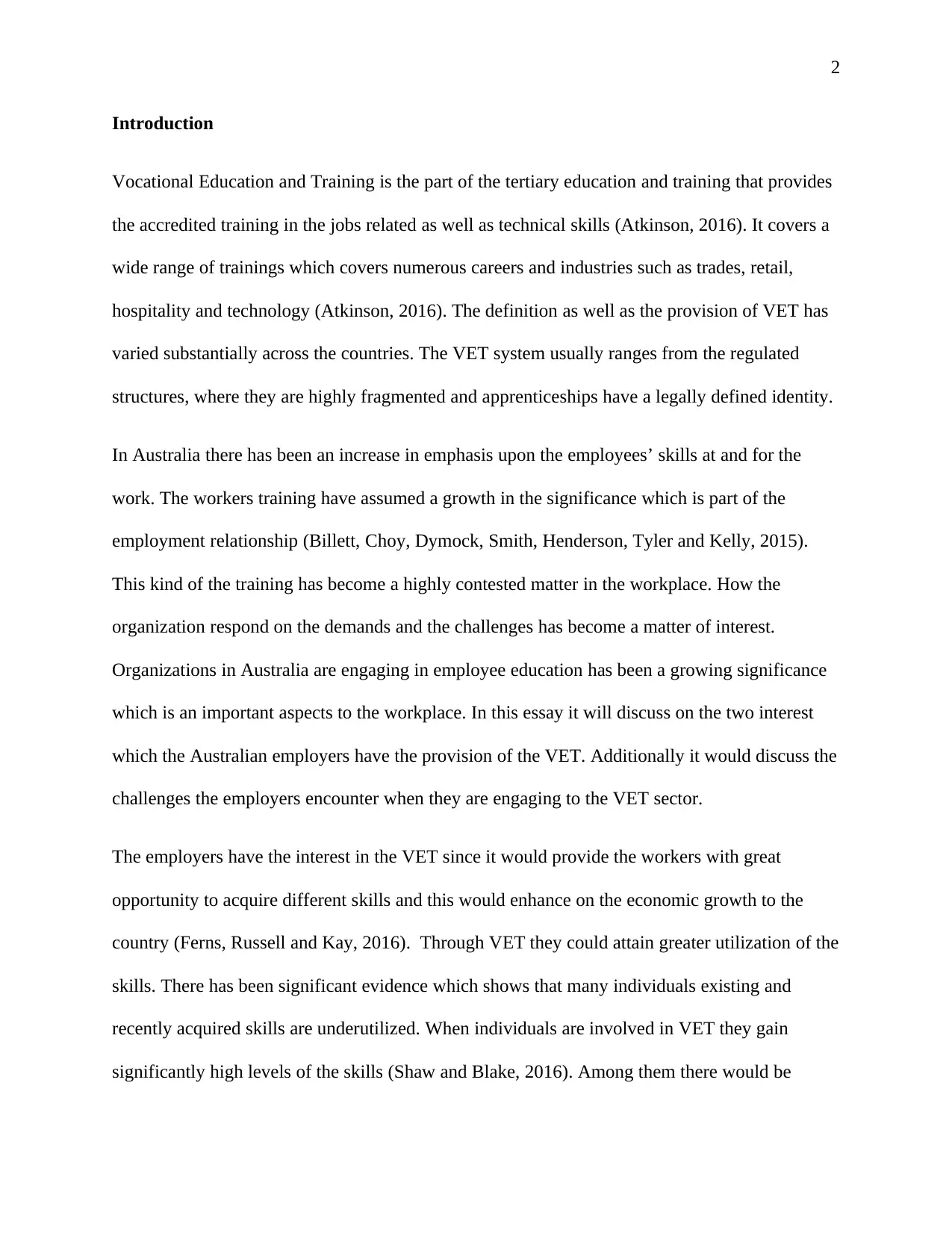
2
Introduction
Vocational Education and Training is the part of the tertiary education and training that provides
the accredited training in the jobs related as well as technical skills (Atkinson, 2016). It covers a
wide range of trainings which covers numerous careers and industries such as trades, retail,
hospitality and technology (Atkinson, 2016). The definition as well as the provision of VET has
varied substantially across the countries. The VET system usually ranges from the regulated
structures, where they are highly fragmented and apprenticeships have a legally defined identity.
In Australia there has been an increase in emphasis upon the employees’ skills at and for the
work. The workers training have assumed a growth in the significance which is part of the
employment relationship (Billett, Choy, Dymock, Smith, Henderson, Tyler and Kelly, 2015).
This kind of the training has become a highly contested matter in the workplace. How the
organization respond on the demands and the challenges has become a matter of interest.
Organizations in Australia are engaging in employee education has been a growing significance
which is an important aspects to the workplace. In this essay it will discuss on the two interest
which the Australian employers have the provision of the VET. Additionally it would discuss the
challenges the employers encounter when they are engaging to the VET sector.
The employers have the interest in the VET since it would provide the workers with great
opportunity to acquire different skills and this would enhance on the economic growth to the
country (Ferns, Russell and Kay, 2016). Through VET they could attain greater utilization of the
skills. There has been significant evidence which shows that many individuals existing and
recently acquired skills are underutilized. When individuals are involved in VET they gain
significantly high levels of the skills (Shaw and Blake, 2016). Among them there would be
Introduction
Vocational Education and Training is the part of the tertiary education and training that provides
the accredited training in the jobs related as well as technical skills (Atkinson, 2016). It covers a
wide range of trainings which covers numerous careers and industries such as trades, retail,
hospitality and technology (Atkinson, 2016). The definition as well as the provision of VET has
varied substantially across the countries. The VET system usually ranges from the regulated
structures, where they are highly fragmented and apprenticeships have a legally defined identity.
In Australia there has been an increase in emphasis upon the employees’ skills at and for the
work. The workers training have assumed a growth in the significance which is part of the
employment relationship (Billett, Choy, Dymock, Smith, Henderson, Tyler and Kelly, 2015).
This kind of the training has become a highly contested matter in the workplace. How the
organization respond on the demands and the challenges has become a matter of interest.
Organizations in Australia are engaging in employee education has been a growing significance
which is an important aspects to the workplace. In this essay it will discuss on the two interest
which the Australian employers have the provision of the VET. Additionally it would discuss the
challenges the employers encounter when they are engaging to the VET sector.
The employers have the interest in the VET since it would provide the workers with great
opportunity to acquire different skills and this would enhance on the economic growth to the
country (Ferns, Russell and Kay, 2016). Through VET they could attain greater utilization of the
skills. There has been significant evidence which shows that many individuals existing and
recently acquired skills are underutilized. When individuals are involved in VET they gain
significantly high levels of the skills (Shaw and Blake, 2016). Among them there would be
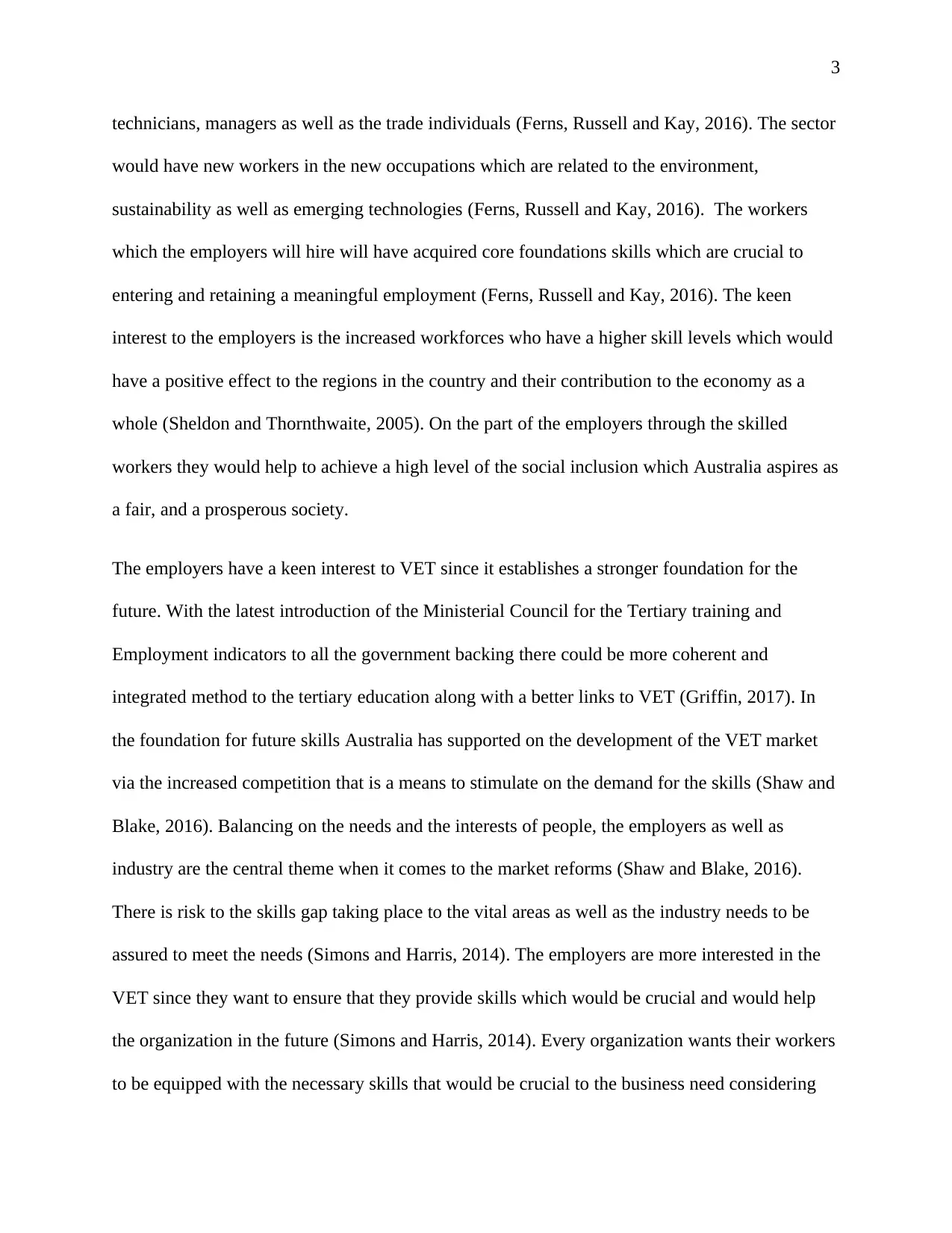
3
technicians, managers as well as the trade individuals (Ferns, Russell and Kay, 2016). The sector
would have new workers in the new occupations which are related to the environment,
sustainability as well as emerging technologies (Ferns, Russell and Kay, 2016). The workers
which the employers will hire will have acquired core foundations skills which are crucial to
entering and retaining a meaningful employment (Ferns, Russell and Kay, 2016). The keen
interest to the employers is the increased workforces who have a higher skill levels which would
have a positive effect to the regions in the country and their contribution to the economy as a
whole (Sheldon and Thornthwaite, 2005). On the part of the employers through the skilled
workers they would help to achieve a high level of the social inclusion which Australia aspires as
a fair, and a prosperous society.
The employers have a keen interest to VET since it establishes a stronger foundation for the
future. With the latest introduction of the Ministerial Council for the Tertiary training and
Employment indicators to all the government backing there could be more coherent and
integrated method to the tertiary education along with a better links to VET (Griffin, 2017). In
the foundation for future skills Australia has supported on the development of the VET market
via the increased competition that is a means to stimulate on the demand for the skills (Shaw and
Blake, 2016). Balancing on the needs and the interests of people, the employers as well as
industry are the central theme when it comes to the market reforms (Shaw and Blake, 2016).
There is risk to the skills gap taking place to the vital areas as well as the industry needs to be
assured to meet the needs (Simons and Harris, 2014). The employers are more interested in the
VET since they want to ensure that they provide skills which would be crucial and would help
the organization in the future (Simons and Harris, 2014). Every organization wants their workers
to be equipped with the necessary skills that would be crucial to the business need considering
technicians, managers as well as the trade individuals (Ferns, Russell and Kay, 2016). The sector
would have new workers in the new occupations which are related to the environment,
sustainability as well as emerging technologies (Ferns, Russell and Kay, 2016). The workers
which the employers will hire will have acquired core foundations skills which are crucial to
entering and retaining a meaningful employment (Ferns, Russell and Kay, 2016). The keen
interest to the employers is the increased workforces who have a higher skill levels which would
have a positive effect to the regions in the country and their contribution to the economy as a
whole (Sheldon and Thornthwaite, 2005). On the part of the employers through the skilled
workers they would help to achieve a high level of the social inclusion which Australia aspires as
a fair, and a prosperous society.
The employers have a keen interest to VET since it establishes a stronger foundation for the
future. With the latest introduction of the Ministerial Council for the Tertiary training and
Employment indicators to all the government backing there could be more coherent and
integrated method to the tertiary education along with a better links to VET (Griffin, 2017). In
the foundation for future skills Australia has supported on the development of the VET market
via the increased competition that is a means to stimulate on the demand for the skills (Shaw and
Blake, 2016). Balancing on the needs and the interests of people, the employers as well as
industry are the central theme when it comes to the market reforms (Shaw and Blake, 2016).
There is risk to the skills gap taking place to the vital areas as well as the industry needs to be
assured to meet the needs (Simons and Harris, 2014). The employers are more interested in the
VET since they want to ensure that they provide skills which would be crucial and would help
the organization in the future (Simons and Harris, 2014). Every organization wants their workers
to be equipped with the necessary skills that would be crucial to the business need considering
⊘ This is a preview!⊘
Do you want full access?
Subscribe today to unlock all pages.

Trusted by 1+ million students worldwide
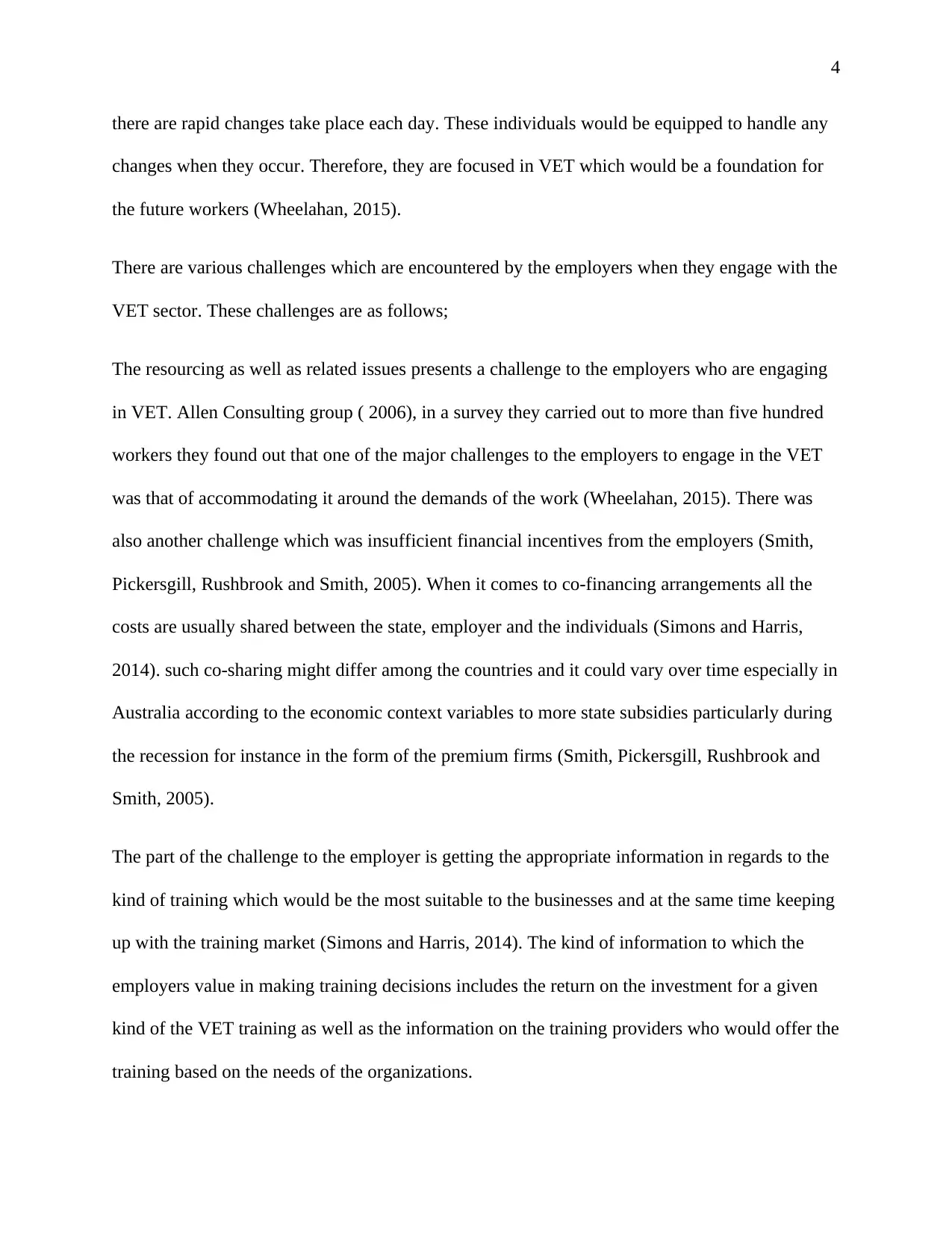
4
there are rapid changes take place each day. These individuals would be equipped to handle any
changes when they occur. Therefore, they are focused in VET which would be a foundation for
the future workers (Wheelahan, 2015).
There are various challenges which are encountered by the employers when they engage with the
VET sector. These challenges are as follows;
The resourcing as well as related issues presents a challenge to the employers who are engaging
in VET. Allen Consulting group ( 2006), in a survey they carried out to more than five hundred
workers they found out that one of the major challenges to the employers to engage in the VET
was that of accommodating it around the demands of the work (Wheelahan, 2015). There was
also another challenge which was insufficient financial incentives from the employers (Smith,
Pickersgill, Rushbrook and Smith, 2005). When it comes to co-financing arrangements all the
costs are usually shared between the state, employer and the individuals (Simons and Harris,
2014). such co-sharing might differ among the countries and it could vary over time especially in
Australia according to the economic context variables to more state subsidies particularly during
the recession for instance in the form of the premium firms (Smith, Pickersgill, Rushbrook and
Smith, 2005).
The part of the challenge to the employer is getting the appropriate information in regards to the
kind of training which would be the most suitable to the businesses and at the same time keeping
up with the training market (Simons and Harris, 2014). The kind of information to which the
employers value in making training decisions includes the return on the investment for a given
kind of the VET training as well as the information on the training providers who would offer the
training based on the needs of the organizations.
there are rapid changes take place each day. These individuals would be equipped to handle any
changes when they occur. Therefore, they are focused in VET which would be a foundation for
the future workers (Wheelahan, 2015).
There are various challenges which are encountered by the employers when they engage with the
VET sector. These challenges are as follows;
The resourcing as well as related issues presents a challenge to the employers who are engaging
in VET. Allen Consulting group ( 2006), in a survey they carried out to more than five hundred
workers they found out that one of the major challenges to the employers to engage in the VET
was that of accommodating it around the demands of the work (Wheelahan, 2015). There was
also another challenge which was insufficient financial incentives from the employers (Smith,
Pickersgill, Rushbrook and Smith, 2005). When it comes to co-financing arrangements all the
costs are usually shared between the state, employer and the individuals (Simons and Harris,
2014). such co-sharing might differ among the countries and it could vary over time especially in
Australia according to the economic context variables to more state subsidies particularly during
the recession for instance in the form of the premium firms (Smith, Pickersgill, Rushbrook and
Smith, 2005).
The part of the challenge to the employer is getting the appropriate information in regards to the
kind of training which would be the most suitable to the businesses and at the same time keeping
up with the training market (Simons and Harris, 2014). The kind of information to which the
employers value in making training decisions includes the return on the investment for a given
kind of the VET training as well as the information on the training providers who would offer the
training based on the needs of the organizations.
Paraphrase This Document
Need a fresh take? Get an instant paraphrase of this document with our AI Paraphraser
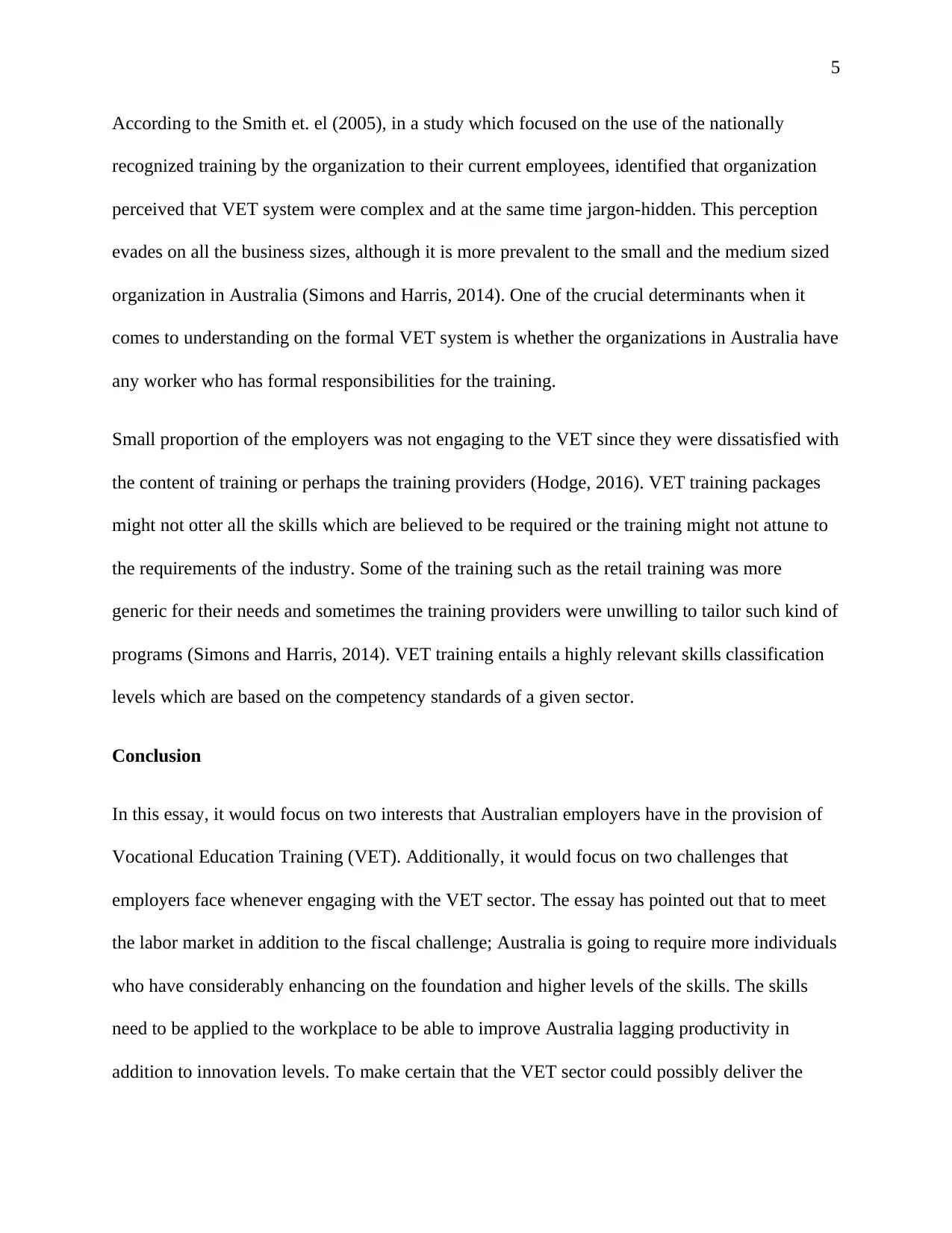
5
According to the Smith et. el (2005), in a study which focused on the use of the nationally
recognized training by the organization to their current employees, identified that organization
perceived that VET system were complex and at the same time jargon-hidden. This perception
evades on all the business sizes, although it is more prevalent to the small and the medium sized
organization in Australia (Simons and Harris, 2014). One of the crucial determinants when it
comes to understanding on the formal VET system is whether the organizations in Australia have
any worker who has formal responsibilities for the training.
Small proportion of the employers was not engaging to the VET since they were dissatisfied with
the content of training or perhaps the training providers (Hodge, 2016). VET training packages
might not otter all the skills which are believed to be required or the training might not attune to
the requirements of the industry. Some of the training such as the retail training was more
generic for their needs and sometimes the training providers were unwilling to tailor such kind of
programs (Simons and Harris, 2014). VET training entails a highly relevant skills classification
levels which are based on the competency standards of a given sector.
Conclusion
In this essay, it would focus on two interests that Australian employers have in the provision of
Vocational Education Training (VET). Additionally, it would focus on two challenges that
employers face whenever engaging with the VET sector. The essay has pointed out that to meet
the labor market in addition to the fiscal challenge; Australia is going to require more individuals
who have considerably enhancing on the foundation and higher levels of the skills. The skills
need to be applied to the workplace to be able to improve Australia lagging productivity in
addition to innovation levels. To make certain that the VET sector could possibly deliver the
According to the Smith et. el (2005), in a study which focused on the use of the nationally
recognized training by the organization to their current employees, identified that organization
perceived that VET system were complex and at the same time jargon-hidden. This perception
evades on all the business sizes, although it is more prevalent to the small and the medium sized
organization in Australia (Simons and Harris, 2014). One of the crucial determinants when it
comes to understanding on the formal VET system is whether the organizations in Australia have
any worker who has formal responsibilities for the training.
Small proportion of the employers was not engaging to the VET since they were dissatisfied with
the content of training or perhaps the training providers (Hodge, 2016). VET training packages
might not otter all the skills which are believed to be required or the training might not attune to
the requirements of the industry. Some of the training such as the retail training was more
generic for their needs and sometimes the training providers were unwilling to tailor such kind of
programs (Simons and Harris, 2014). VET training entails a highly relevant skills classification
levels which are based on the competency standards of a given sector.
Conclusion
In this essay, it would focus on two interests that Australian employers have in the provision of
Vocational Education Training (VET). Additionally, it would focus on two challenges that
employers face whenever engaging with the VET sector. The essay has pointed out that to meet
the labor market in addition to the fiscal challenge; Australia is going to require more individuals
who have considerably enhancing on the foundation and higher levels of the skills. The skills
need to be applied to the workplace to be able to improve Australia lagging productivity in
addition to innovation levels. To make certain that the VET sector could possibly deliver the

6
right skills and avoid shortages of skills there is need to co-ordinate action on the skills strategies
to the specialized occupations.
right skills and avoid shortages of skills there is need to co-ordinate action on the skills strategies
to the specialized occupations.
⊘ This is a preview!⊘
Do you want full access?
Subscribe today to unlock all pages.

Trusted by 1+ million students worldwide
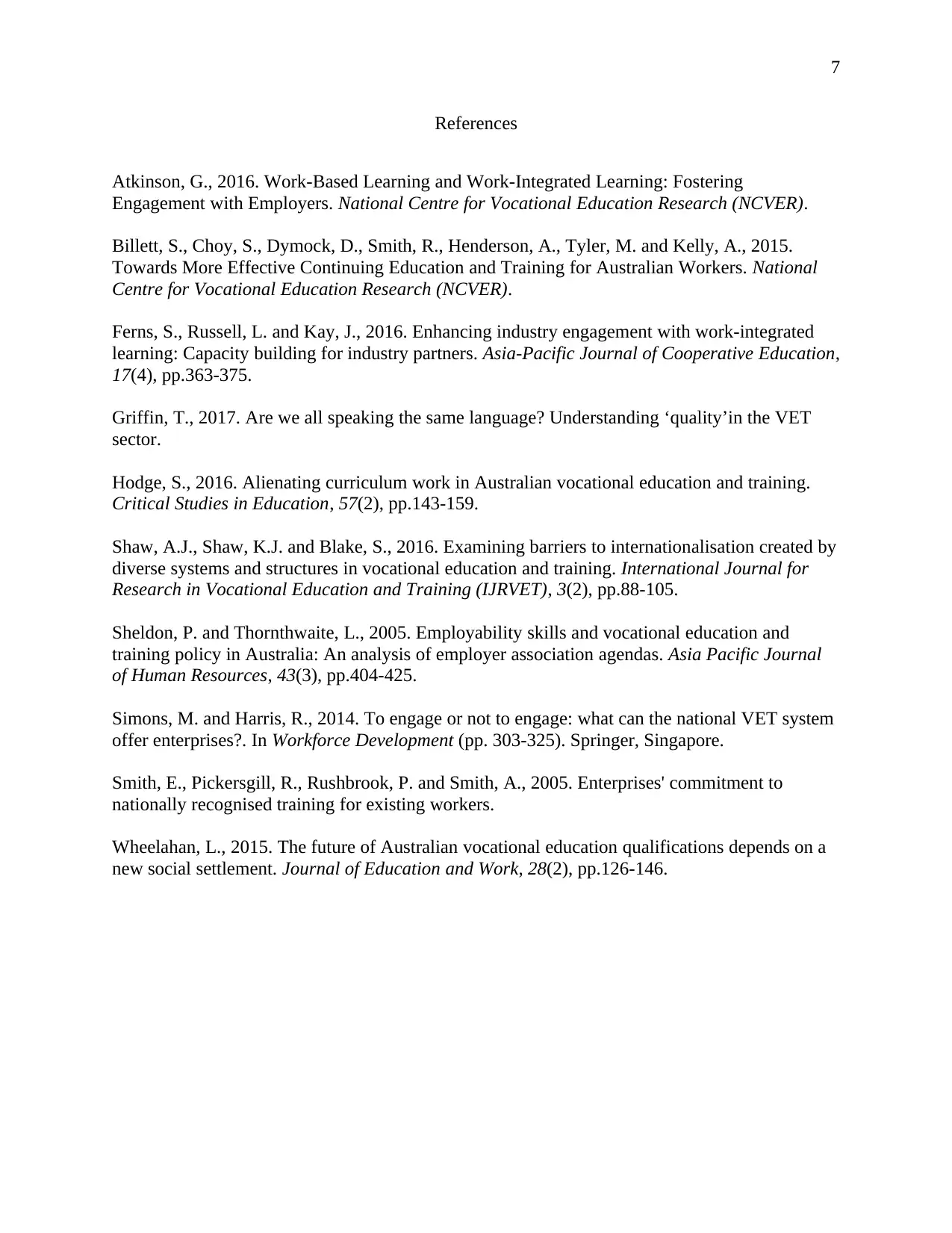
7
References
Atkinson, G., 2016. Work-Based Learning and Work-Integrated Learning: Fostering
Engagement with Employers. National Centre for Vocational Education Research (NCVER).
Billett, S., Choy, S., Dymock, D., Smith, R., Henderson, A., Tyler, M. and Kelly, A., 2015.
Towards More Effective Continuing Education and Training for Australian Workers. National
Centre for Vocational Education Research (NCVER).
Ferns, S., Russell, L. and Kay, J., 2016. Enhancing industry engagement with work-integrated
learning: Capacity building for industry partners. Asia-Pacific Journal of Cooperative Education,
17(4), pp.363-375.
Griffin, T., 2017. Are we all speaking the same language? Understanding ‘quality’in the VET
sector.
Hodge, S., 2016. Alienating curriculum work in Australian vocational education and training.
Critical Studies in Education, 57(2), pp.143-159.
Shaw, A.J., Shaw, K.J. and Blake, S., 2016. Examining barriers to internationalisation created by
diverse systems and structures in vocational education and training. International Journal for
Research in Vocational Education and Training (IJRVET), 3(2), pp.88-105.
Sheldon, P. and Thornthwaite, L., 2005. Employability skills and vocational education and
training policy in Australia: An analysis of employer association agendas. Asia Pacific Journal
of Human Resources, 43(3), pp.404-425.
Simons, M. and Harris, R., 2014. To engage or not to engage: what can the national VET system
offer enterprises?. In Workforce Development (pp. 303-325). Springer, Singapore.
Smith, E., Pickersgill, R., Rushbrook, P. and Smith, A., 2005. Enterprises' commitment to
nationally recognised training for existing workers.
Wheelahan, L., 2015. The future of Australian vocational education qualifications depends on a
new social settlement. Journal of Education and Work, 28(2), pp.126-146.
References
Atkinson, G., 2016. Work-Based Learning and Work-Integrated Learning: Fostering
Engagement with Employers. National Centre for Vocational Education Research (NCVER).
Billett, S., Choy, S., Dymock, D., Smith, R., Henderson, A., Tyler, M. and Kelly, A., 2015.
Towards More Effective Continuing Education and Training for Australian Workers. National
Centre for Vocational Education Research (NCVER).
Ferns, S., Russell, L. and Kay, J., 2016. Enhancing industry engagement with work-integrated
learning: Capacity building for industry partners. Asia-Pacific Journal of Cooperative Education,
17(4), pp.363-375.
Griffin, T., 2017. Are we all speaking the same language? Understanding ‘quality’in the VET
sector.
Hodge, S., 2016. Alienating curriculum work in Australian vocational education and training.
Critical Studies in Education, 57(2), pp.143-159.
Shaw, A.J., Shaw, K.J. and Blake, S., 2016. Examining barriers to internationalisation created by
diverse systems and structures in vocational education and training. International Journal for
Research in Vocational Education and Training (IJRVET), 3(2), pp.88-105.
Sheldon, P. and Thornthwaite, L., 2005. Employability skills and vocational education and
training policy in Australia: An analysis of employer association agendas. Asia Pacific Journal
of Human Resources, 43(3), pp.404-425.
Simons, M. and Harris, R., 2014. To engage or not to engage: what can the national VET system
offer enterprises?. In Workforce Development (pp. 303-325). Springer, Singapore.
Smith, E., Pickersgill, R., Rushbrook, P. and Smith, A., 2005. Enterprises' commitment to
nationally recognised training for existing workers.
Wheelahan, L., 2015. The future of Australian vocational education qualifications depends on a
new social settlement. Journal of Education and Work, 28(2), pp.126-146.
1 out of 7
Related Documents
Your All-in-One AI-Powered Toolkit for Academic Success.
+13062052269
info@desklib.com
Available 24*7 on WhatsApp / Email
![[object Object]](/_next/static/media/star-bottom.7253800d.svg)
Unlock your academic potential
Copyright © 2020–2025 A2Z Services. All Rights Reserved. Developed and managed by ZUCOL.



